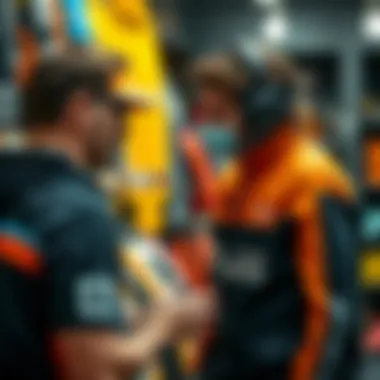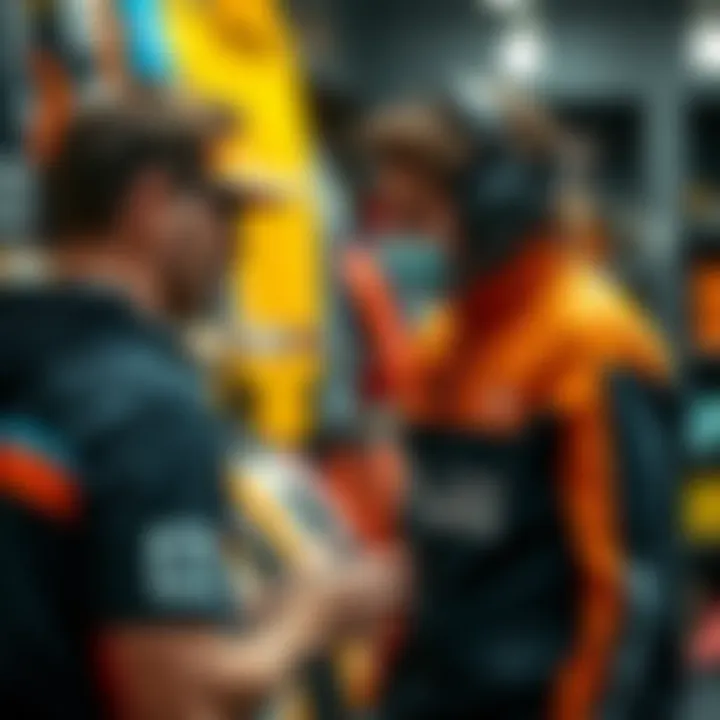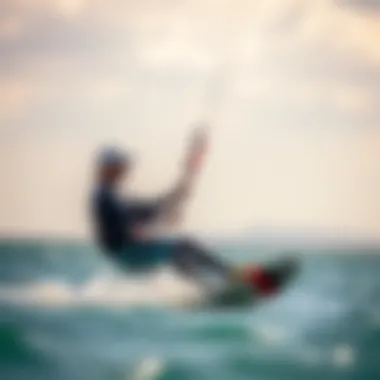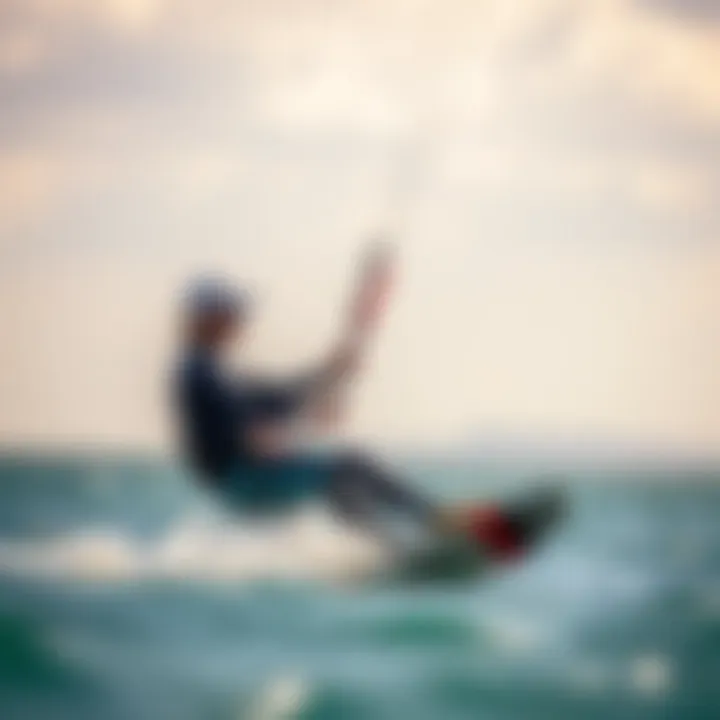Exploring the Kitesurfing Shop Experience and Essentials


Intro
Kitesurfing isn't just about catching waves; it’s about a community that thrives in the heart of sporting shops. From novice riders to seasoned veterans, kitesurfing shops serve as vital hubs for the kiteboarding community. Here, enthusiasts can not only find gear but also gather insights and camaraderie that enhance their riding experience. The atmosphere in these shops is remarkable, infused with a sense of adventure and shared passion for the water.
As we unravel the layers of the kitesurfing shop experience, we'll explore essential gear tailored to different skill levels, advanced equipment for the more daring, and a wealth of techniques that help riders conquer the water. Through a closer look at what these shops offer, we’ll see how they play a role bigger than just a retail environment; they are an essential part of the kitesurfing lifestyle.
Gear and Equipment
Essential Kiteboarding Gear for Beginners
When someone takes their first steps into kitesurfing, the range of gear available might feel overwhelming. Beginners need to focus on quality yet accessible items that set a strong foundation for their experience. Essential gear includes:
- Kite: Look for a durable and versatile kite. A size range of 9 to 12 square meters is generally a good place to start, depending on the rider's weight and typical wind conditions.
- Control Bar: This piece is crucial, connecting the kite to the rider and allowing for steering. Beginners should consider a bar that is comfortable and easy to grip.
- Board: A twin-tip board that offers a good balance between stability and performance is ideal for newcomers. It should have a suitable width to help with flotation during those early sessions.
- Harness: A comfortable and secure harness can mean the difference between an enjoyable experience and battling discomfort. A seat or waist harness can be chosen based on personal preference.
- Safety Gear: Helmets and impact vests provide essential protection against falls, especially in those early days of learning.
To further ease into this passion, learning from knowledgeable staff at kitesurfing shops can profoundly benefit newcomers, as they can provide tailored recommendations and crucial safety tips.
Advanced Equipment for Experienced Riders
As riders progress, so does their appetite for more specialized gear. Experienced kitesurfers often seek equipment tailored to their performance needs and riding style. Here are a few advanced essentials that can elevate the riding experience:
- High-Performance Kites: Brands like Naish and Duotone offer kites designed with advanced features for increased responsiveness and handling in various wind conditions.
- Freestyle Boards: Riders interested in tricks will benefit from lighter boards with a more flexible design to help execute those spins and jumps with flair. Look for brands like Liquid Force for innovations in this category.
- Foil Boards: A captivating option for speed lovers, foil boards allow riders to soar above the water's surface. The sensation of gliding without the friction of a traditional board is something else entirely.
- Specialized Harnesses: As kitesurfers advance to exploring different styles, having a harness that caters to their particular needs becomes vital. Waist harnesses provide more freedom of movement and comfort during extended sessions.
Understanding these components and how they relate to one’s riding style is crucial for any serious kitesurfer looking to refine their skills and gain an edge on the water.
Techniques and Tips
Safety Practices for Kiteboarding
Safety should always be a primary focus, no matter one's level of expertise. Engaging with experienced peers in a shop can highlight important safety measures, like checking wind conditions and understanding local waterway regulations. Some essential practices include:
- Inspecting Gear: Before heading out, examine all equipment to ensure it is in good working order. Look for frays in lines and check the integrity of the harness.
- Understanding Weather Patterns: Knowing how to read wind and weather conditions can prevent stormy encounters that can jeopardize safety.
- Use the Buddy System: It’s always advisable to kite with a partner. Not only is it more enjoyable, but it also adds a layer of safety when tackling the water.
These practices are often discussed in kitesurfing shops, and staff can share personal experiences that might help guide beginners toward safer habits.
Training Techniques to Improve Your Skills
Gaining mastery involves dedication and consistent practice. Kitesurfing shops often host or promote local training sessions that can be invaluable. Here are a few techniques to consider:
- Join Local Classes: Many shops offer classes or can direct you to instructors who specialize in different aspects of kitesurfing, from basic maneuvers to advanced tricks.
- Recorded Practice: Using a GoPro or similar camera to record sessions can help identify areas for improvement by allowing riders to visually analyze their performance.
- Community Connections: Engaging with other kitesurfers enhances learning. Shops often organize meetups where individuals can share tips, techniques, and experiences that could drastically impact skill improvement.
Kitesurfing isn't just an individual sport; it thrives on the network and experiences shared within the community. The insightful interactions within these shops can help unpack a wealth of knowledge, subtly enhancing the overall kiteboarding experience.
"Kitesurfing shops are like the beating hearts of the kiteboarding community, where passion meets expertise."
This guide serves as a glimpse into how kitesurfing shops provide more than just the equipment; they foster an environment where knowledge, safety, and community blend together, ultimately enriching the kiteboarding journey for every enthusiast. For ongoing discussions, inspiration, or advice, platforms like Reddit and Facebook connect riders from across the globe. \n Explore further at sites like Wikipedia or Britannica to deepen your understanding of kitesurfing and its vibrant, growing community.
Intro to Kitesurfing Shops
The world of kitesurfing shops is more than just a retail environment; it's a hub for enthusiasts. These spaces offer valuable resources that cater to the diverse needs of both newcomers and seasoned kiteboarders. Understanding the significance of kitesurfing shops is essential for any enthusiast aiming to enhance their experience on the water.
The importance of kitesurfing shops cannot be overstated. They act as the nerve center for education, gear procurement, and community building. Each element of the shop serves a purpose that goes beyond mere transactions. When you step into a kitesurfing shop, it’s akin to walking into a sanctuary where your passion is recognized and nurtured. Here, you will find the insights and expertise that are vital for safe and enjoyable kiteboarding.
Some key benefits of kitesurfing shops include:
- Personalized Guidance: Knowledgeable staff can help you select the right gear tailored to your skill level and style.
- Hands-on Experience: Being able to physically inspect and even test equipment makes it easier to make informed choices.
- Community Connections: These shops often host events and classes, enabling kitesurfers to network and share experiences.
- Diverse Offerings: Beyond just equipment, shops provide resources such as lessons, workshops, and safety gear.
In short, kitesurfing shops are indispensable for thriving within the kiteboarding community. Whether you seek guidance on the latest innovations or simply want to connect with local talent, understanding their role adds layers of value to your kitesurfing experience.
Understanding the Kitesurfing Sport
Kitesurfing itself is a sport that blends elements of surfing, wakeboarding, and paragliding. Utilizing a kite to harness wind power allows riders to glide over water. Hence, understanding kitesurfing is the first step to appreciating the importance of these specialty shops. The sport isn’t just about the thrill; it also embraces a culture that cherishes freedom, adventure, and collaboration.
What many may not realize is that kitesurfing requires not only physical skill but also knowledge of weather patterns, safety protocols, and gear operations. It’s a blend of physical prowess and strategic thinking. Before setting sail, a rider must consider wind conditions, tides, and shifts in weather patterns. This awareness adds both complexity and excitement to the practice of kitesurfing.
Additionally, the community surrounding kitesurfing plays a significant role in its growth and evolution. Participating in group activities, competitions, and social meet-ups fosters a spirit of camaraderie that enhances the overall experience.
The Role of Kitesurfing Shops
Kitesurfing shops fulfill crucial functions that sustain the community and facilitate individual growth. They provide a space where knowledge meets product availability. For example, these shops often stock everything from kites to individual fins, serving as a one-stop shop for any kitesurfing needs.


Key responsibilities of kitesurfing shops include:
- Product Variety: From beginner kites to advanced harnesses, shops cater to all levels,
- Expert Consultation: Staff with real-world experience can offer tailored advice, ensuring you choose the right items.
- Testing Events: Many shops organize demo days, where customers can try out different gear before buying.
- Educational Resources: Workshops are often hosted, providing lessons on various aspects, from gear maintenance to safety.
Moreover, the role of kitesurfing shops transcends sales. They help to shape the culture of kitesurfing, creating spaces where friendships blossom and shared interests come to life. When visiting a kitesurfing shop, you’re not just engaging in commerce, but stepping into a thriving ecosystem committed to enhancing your kitesurfing journey.
Essential Gear and Equipment
When it comes to kitesurfing, the right gear is essential for both safety and performance. Whether you are a seasoned pro or a newbie just catching your first wave, understanding the nuances of kitesurfing gear can make all the difference in your experience on the water. The world of kitesurfing equipment encompasses a range of products tailored to meet various styles, skill levels, and weather conditions.
Kites: Types and Specifications
Kites are the heart and soul of kitesurfing. There are several types to choose from, each designed with specific characteristics suited to different wind conditions and rider preferences. Some common types include:
- Leisure Kites: Ideal for beginner riders, these offer stability and ease of control. They are usually larger, which helps in low wind conditions.
- Freestyle Kites: Aimed at those who want to perform tricks. These kites are generally more agile, allowing for higher jumps and spins.
- Wave Kites: Designed for those who love to harness the ocean's surf, wave kites offer quick responsiveness and less drag.
When selecting a kite, consider its size and aspect ratio—these factors dictate how it will perform in various wind conditions. Larger kites catch more wind but can be harder to control, while smaller kites are better for high winds and maneuverability.
Boards: Varieties and Functionalities
Choosing the right board is another critical aspect of the kitesurfing experience. The variety of boards available caters to different riding styles. Here’s a brief overview of key types:
- Twin-Tip Boards: Versatile and popular among beginners, these boards can be ridden in both directions. They’re often wider, which grants stability, perfect for choppy waters.
- Directional Boards: Specifically designed for surfing waves, these are akin to surfboards and excel in open water conditions.
- Foil Boards: An emerging trend in the sport, foil boards rise above the water's surface, reducing drag and allowing for smoother rides at lower speeds.
Each board type brings its own performance characteristics, and choosing one can depend on your skill level and desired riding experiences. It’s a good idea to try out different boards to find your fit.
Harnesses and Safety Gear
Safety should never be overlooked in extreme sports, and kitesurfing is no exception. Your harness not only secures you to the kite but also significantly impacts comfort and performance. Types of harnesses include:
- Seat Harnesses: Providing lower back support, these are suitable for beginners and those who prefer a more comfortable ride.
- Waist Harnesses: These provide more freedom of movement and are favored by advanced riders, especially for tricks.
Additionally, investing in other safety gear such as a impact vest, helmet, and LEASH is crucial. A proper leash will keep your kite tethered, preventing it from becoming a runaway during a fall.
Tuning Your Equipment
Tuning your kitesurfing equipment is akin to tweaking a musical instrument to achieve the perfect sound. Small adjustments can lead to significant improvements on the water. Here are some areas to focus on:
- Kite Lines: Ensure your lines are untangled, and check the length. Lines that are too short might restrict your movements, while overly long lines could cause sluggish performance.
- Bridle Adjustments: Tinkering with the bridle settings can influence how the kite reacts to wind. Adjustments can enhance lift and speed but require careful experimentation.
- Board Straps: Altering the position or settings of your board straps affects how securely you feel while riding, impacting both comfort and control.
Taking the time to fine-tune your gear isn't just about optimizing performance; it’s also about enhancing safety and enjoyment on the water. Your kitesurfing setup should feel like an extension of yourself—comfortable and responsive.
In summary, the essential gear and equipment for kitesurfing play a pivotal role in shaping your experience. Selecting the right kites, boards, harnesses, and safety gear, along with understanding how to tune them, empowers you to enjoy the thrill of kiteboarding while maximizing safety and performance.
Navigating the Shopping Experience
When it comes to kitesurfing, the shopping experience plays a pivotal role in how enthusiasts discover, learn, and ultimately enjoy the sport. This section digs into the details of that experience, offering insight into the best practices for both online and brick-and-mortar stores, what to keep an eye out for in a kitesurfing shop, and how to assess customer service. Understanding these elements can significantly enhance your journey through the world of kiteboarding.
Online vs. Physical Stores
The debate between online and physical stores in the kitesurfing realm is much like choosing between wind and no wind for a perfect ride. Each offers distinct advantages and drawbacks.
Advantages of Online Stores:
- Convenience: Shopping online allows you to browse an extensive inventory from the comfort of your couch. It’s like having a whole ocean of options at your fingertips, available 24/7.
- Prices: Often, you might find better deals and discounts online because of lower overhead costs. Sites like kitesurfingshop.com and boardsandkites.com frequently have offers.
Drawbacks of Online Stores:
- No Physical Inspection: You can’t touch the gear or ask questions face-to-face. You might end up with a product that's out of your league or incompatible.
Advantages of Physical Stores:
- Expert Guidance: Knowledgeable staff can provide immediate assistance and tailor recommendations based on your skill level. Sometimes, the right advice can save you from making costly mistakes.
- Try Before You Buy: Being able to examine and feel the equipment allows for a better blend of compatibility and comfort. Plus, testing a harness on your body can reveal how it fits under tension.
Drawbacks of Physical Stores:
- Limited Stock: Physical locations often carry a smaller selection due to space constraints. This means you might not find that dream kite on display.
What to Look for in a Kitesurfing Shop


Finding a reliable kitesurfing shop can be as daunting as waiting for the right wind. Here are key factors that can guide your decision:
- Product Range: The ideal store should offer a wide array of products including kites, boards, harnesses, and safety gear. More offerings typically indicate a deeper understanding of the sport.
- Brand Selection: Look for shops that carry multiple brands. This diversity can give insight into credible products and allow for more tailored options based on your specific needs.
- Knowledgeable Staff: Staff who are passionate and informed about kitesurfing can make all the difference. It’s worth checking if they participate in the sport themselves.
- Customer Reviews: In today’s age, feedback is everything. Scour through reviews on platforms like reddit.com and social media to gauge customer satisfaction. Solid reviews can be a good indicator of a reputable store.
Evaluating Customer Service
Customer service is the backbone of a positive shopping experience. Just like you wouldn’t want a poor wind direction ruining your kitesurfing session, bad service can sour your gear-buying journey. Here’s what to look for:
- Responsiveness: How quick and helpful is their communication? Whether you’re reaching out via email or giving them a call, prompt answers can set the tone for your experience.
- Return Policy: A transparent return policy is essential. Equipment can be a hefty investment, and you want to know you won’t be stuck with something that doesn’t work for you.
- After-Sales Support: Check if the shop offers assistance after your purchase. Sometimes you might have questions once you've gotten home, and a shop that provides follow-up support can make a world of difference.
"Good customer service doesn’t just sell products; it builds a community."
In summary, navigating the shopping experience for kitesurfing gear requires both an understanding of the available outlets and connecting with shops that resonate with your needs. By weighing the options between online and physical stores, knowing what to seek out, and gauging service levels, you can craft a more enriching kitesurfing experience.
Understanding Market Trends
In the ever-evolving world of kitesurfing, staying updated on market trends is not just beneficial—it's essential. Understanding current trends can guide kitesurfers in making informed decisions, whether they are seasoned pros or enthusiastic newcomers. Keeping a pulse on innovations, consumer preferences, and sustainability initiatives can significantly enhance the shopping experience and, ultimately, the sport itself.
The kiteboarding industry is constantly adapting, influenced by technological advancements and changes in consumer priorities. For instance, as more riders focus on eco-friendliness, brands are increasingly investing in sustainable materials and processes. Recognizing these shifts can help kitesurfers choose products that align with their values, encouraging not just personal satisfaction but also a healthier environment.
Being in tune with market trends fosters a community spirit, too. It's about learning from one another. When enthusiasts share insights on the latest gear or eco-friendly options, it cultivates a rich culture of knowledge and inspiration. It's not just gear that evolves; it's a whole ecosystem built around kitesurfing. This interconnectedness enhances the culture of kiteboarding, turning it into a shared passion rather than just an individual endeavor.
"Evaluating market trends does not only prepare you for what’s new; it also gives insight into the larger waves that shape the sport." If kitesurfers can read the tides of change in their industry, they can adapt and thrive amid competition and shifting consumer demands.
Innovations in Kiteboarding Gear
In the world of kitesurfing, innovation is a driving force behind performance and safety. The gear is getting smarter, lighter, and more efficient, introducing features that not only enhance user experience but also cater to a diverse range of skill levels. Take, for example, the new materials such as Dyneema, which are now common in kite construction. These advancements lead to kites that are not only lighter and stronger but also provide better responsiveness in various wind conditions.
- Hydrodynamic Designs: Many recent boards recently come equipped with hydrodynamic designs, offering improved glide and maneuverability. This allows riders to catch more air and perform tricks with greater ease.
- Safety Innovations: Enhancements in safety gear, such as quick-release harnesses, ensure kitesurfers can easily disconnect from their gear in emergencies, providing peace of mind while pursuing the thrill of the water.
Investing in innovative gear can profoundly affect a kitesurfer's performance and enjoyment. Not only does it provide advantages on the water, but it also enhances the overall experience of the sport by allowing for greater creativity and exploration.
Sustainability and Eco-Friendly Products
With increasing awareness of environmental issues, the kitesurfing community is seeing a push towards sustainability. Eco-conscious products are becoming more prevalent, as many brands prioritize sustainability in their manufacturing processes. Kitesurfers now have options that align with their values, allowing them to enjoy their sport without compromising the planet.
- Biodegradable Kites: These innovative designs break down naturally after their lifecycle, significantly reducing waste in oceans and landfills.
- Recycled Materials: Gear made from recycled plastics not only gives new life to old materials but also reduces the demand for new resources, lessening the overall ecological footprint.
Promoting and supporting eco-friendly products is not just a trend; it reflects a movement towards ecological consciousness within the sport. By choosing sustainable equipment, kitesurfers contribute to preserving the beauty of the beaches and oceans they love to ride on.
As we navigate these changing tides, understanding market trends in kitesurfing helps to identify products that enhance performance, promote safety, and protect our environment. With every new advance and commitment towards sustainability, we steer closer to a brighter, more innovative future in kiteboarding.
Community and Events
Kitesurfing is not just a sport; it’s a lifestyle that thrives on community. The connections formed through kitesurfing shops create an ecosystem where knowledge, skills, and camaraderie flourish. In the buzzing world of kitesurfing, shops play a pivotal role in fostering relationships that enrich the overall experience for enthusiasts.
Building Connections Through Kitesurfing Shops
Kitesurfing shops often serve as the cornerstone of local kiteboarding communities. They provide a space where individuals from all backgrounds can come together, share experiences, and lean on each other for support and guidance. Whether you are a novice curious about the wind or a seasoned pro seeking the latest gear, these shops facilitate bonding among individuals who share a passion.
The relationships built in these environments can lead to lifelong friendships and even mentorship opportunities. For instance, a beginner might find a mentor in a knowledgeable shop employee or a fellow shopper who’s been riding waves for years. This informal networking enriches the learning curve and provides encouragement that can propel newcomers from their first attempts to confident rides.
- Support System: New kitesurfers often feel overwhelmed. Shops offer classes and events where they can find people who were once in their shoes.
- Networking: Individuals frequently share stories and tips, helping others navigate local conditions or find the best spots.
- Resource Accessibility: Local shops might provide exclusive insights into upcoming events and competitions, fostering a sense of belonging.
Kitesurfing Competitions and Gatherings
Events and competitions hosted by kitesurfing shops are integral to fostering a robust community spirit. These gatherings serve as opportunities for enthusiasts to showcase their skills, while also enhancing their commitment to the sport. Competitions, big or small, bring out the competitive spirit while encouraging personal growth and team spirit.
These events can range from local fun competitions to national championship extravaganzas. Participants often push their limits, inspiring others to join in or step up their game. For instance, during events, shops often set up tents to provide gear, refreshments, and often host workshops to instruct spectators or wannabe kiteboarders on the basics of the sport.
- Skill Sharing: Competitions highlight varied skill levels, allowing beginners to learn from advanced riders.
- Camaraderie: The atmosphere buzzes with excitement as participants rally together, often creating a festive environment that reinforces connections.
- Broader Reach: Competitions can also attract spectators who may not be familiar with kitesurfing. This piques their interest and can result in new enthusiasts eager to try out the sport.
"In kitesurfing, it’s a tight-knit group that thrives on shared experiences. Every event is a chance to lift each other up and celebrate the thrill of the ride together."
Thus, kitesurfing shops are more than just stores; they are community hubs where events amplify the collective experience of the sport. The friendships made, the lessons learned, and the shared excitement contribute to the larger narrative of kitesurfing culture, making it all the richer.
Expert Advice and Education
Understanding kitesurfing is not just about mastering the equipment; it's equally about acquiring the knowledge necessary to navigate the sport safely and effectively. Expert advice and education form the backbone of what kitesurfing shops offer, and it's essential for users at all levels—from complete beginners to seasoned pros.


The importance of these resources cannot be overstated. First and foremost, they help bridge the gap between theory and practice. Shop staff typically have firsthand experience in the sport. They can provide insights that you're simply not going to find in instructional videos or websites. The value of learning from someone who has weathered various conditions cannot be emphasized enough. Many kitesurfers often recount how a simple tip about kite control or wind patterns changed their entire game.
Additionally, kitesurfing shops serve as local hubs for education. Through workshops or small classes, these venues allow enthusiasts to gather, share experiences, and learn from one another. This communal aspect is invaluable. Over time, you build a rapport and a support system. Such connections can lead to collaborations or even friendships, deepening one’s involvement in the kitesurfing culture.
Lastly, having access to expert advice ensures that you are purchasing the right gear tailored to your skill level and body type. Making the wrong choice can be costly—not just financially but also in terms of safety and enjoyment.
"Knowledge is power. The right advice can be the difference between soaring through the sky and losing your balance on a gusty day."
Lessons and Certifications
In the world of kitesurfing, lessons are crucial. Many top-tier kitesurfing shops also offer certifications that validate your skills. While it may feel tempting to hop on a board and go, investing your time in taking structured lessons is a smart move. This structured approach not only boosts your confidence but also equips you with vital skills you might otherwise overlook. For example, the basics of wind direction and kite handling are best learned hands-on.
Certification programs can range from beginner to advanced levels and typically assure others that you know your stuff when you're out there on the water. For shops and instructors, this is a win-win situation. Customers know they’re dealing with trained professionals, and shops establish credibility in the kitesurfing community.
A particularly interesting aspect of many kitesurfing certifications is the way they focus on safety and responsibility. As a kitesurfer, understanding the importance of safety procedures can prevent accidents that might occur due to inexperience or misunderstandings of the environmental conditions.
Safety Guidelines for Kitesurfers
Safety should never take a backseat in kitesurfing, and the guidelines offered by shops can mean the difference between a thrilling day on the water and a trip to the hospital. Shops typically instill the importance of several basic safety protocols, like checking your gear before heading out and understanding your environment, including wind conditions and potential hazards.
Common safety guidelines include:
- Always wear a certified life vest and a helmet.
- Make sure your equipment is in pristine condition, checking for any signs of wear or damage.
- Never kitesurf alone, especially when you’re just starting. Buddy systems really can help out in emergencies.
- Always inform someone about your plans and when to expect you back.
Reading conditions correctly and knowing your limits are critical components that shops emphasize in their safety training. The sport can be incredibly rewarding, provided that the rules and safety guidelines are adhered to strictly.
In summary, whether you're seeking guidance from staff, attending lessons, or diving into certification programs, doing your homework will ultimately lead to a more enjoyable and safer kitesurfing experience. Invest a bit of time into education and you’ll surely reap the benefits out on the waves.
Future of Kitesurfing Shops
In the ever-evolving landscape of outdoor sports, kitesurfing shops are at a critical juncture. As the needs and preferences of consumers shift, understanding these changes is essential for shops looking to thrive. Kitesurfing isn't just a sport; it's an experience that draws in a diverse group of enthusiasts. Therefore, the future of kitesurfing shops isn’t simply about selling gear; it's also about adapting to a community that seeks connection, knowledge, and cutting-edge products.
Adapting to Changing Consumer Preferences
In recent years, kitesurfing has seen a tremendous uptick in popularity, leading to a more varied customer base. From seasoned riders to curious newcomers, shops need to cater to a wide range of preferences. This adaptation can take several forms:
- Diverse Product Lines: Consumers often seek gear that reflects their personal style or specific needs. Shops may find it beneficial to stock a wider array of kites, boards, and accessories tailored to different skill levels and preferences. For instance, offering eco-friendly options could attract environmentally-conscious buyers.
- Customization: Many kitesurfers now desire customized equipment that fits their unique specifications. Being able to personalize gear allows customers to feel more connected to their equipment, enhancing their overall experience.
- Community-Centric Events: Hosting workshops or social gatherings can foster a sense of belonging. Support from knowledgeable staff can make a significant impact in creating an inviting atmosphere for both beginners and pros.
Adapting in this way not only meets customer expectations but also builds loyalty. A customer who feels understood and valued is likely to return.
Technological Advances and Their Impact
Technology is revolutionizing the kitesurfing industry. Modern advancements are making it easier for shops to stay ahead of the curve. Here are a few pivotal innovations:
- Smart Gear: Emerging technologies include kites with built-in sensors that provide real-time performance feedback. This allows riders to enhance their skills and tailor their experience. Kitesurfing shops can capitalize on this trend by offering the latest smart equipment.
- Online Integration: The integration of online shopping with in-store experiences cannot be overstated. Customers might start their search online and finish their purchase in-store. Shops should consider investing in a robust e-commerce platform that complements their physical presence. Online reviews and ratings can also serve as a persuasive tool for potential buyers.
- Virtual Reality Experiences: Some shops are beginning to experiment with virtual reality setups that allow customers to "try before they buy." This technology offers an immersive way to gauge interest in particular gear, generating excitement and engagement.
"As technology advances, kitesurfing shops must not only adapt but also anticipate the wants of their customers. It's a game of staying one step ahead."
Through these advancements, kitesurfing shops can enhance customer experience and streamline sales, making the shopping journey more engaging.
End
The future holds both challenges and opportunities for kitesurfing shops. By focusing on adapting to the diverse preferences of consumers and embracing technological advances, these establishments can continue to flourish. It’s not just about what gear you sell; it's also about how you connect with the community. In a sport that celebrates freedom and adventure, kitesurfing shops can become a cornerstone of the experience.
End
Kitesurfing shops play a pivotal role in shaping the experience of both budding and seasoned kiteboarders. They are not just retail spaces; rather, they function as community hubs that offer guidance, gear, and an enriched understanding of the sport. The significance of these shops extends far beyond mere transactions; they contribute to the overall health of the kitesurfing culture by fostering a sense of belonging and camaraderie. When a kitesurfer steps into a shop, they enter a space where expertise is readily available, fostering a connection that transcends the act of buying equipment.
Summing Up the Importance of Kitesurfing Shops
The essential function of kitesurfing shops is to bridge the gap between equipment and user knowledge. They provide a wealth of information on the various types of gear, such as kites and boards, ensuring that every customer leaves with the right fit for their skills and needs. These shops also keep a finger on the pulse of the latest market trends. As innovations in gear emerge, kitesurfing shops often serve as the first point of contact for enthusiasts eager to adopt cutting-edge technology.
Moreover, the knowledgeable staff typically comprises avid kitesurfers themselves, enabling them to give firsthand accounts of the gear they sell. This authentic relationship enhances the shopping experience significantly, as customers feel more confident in their purchases. The ability to touch, feel, and even test gear before making a decision cannot be understated.
Kitesurfing shops provide a sanctuary for those looking to escape the day-to-day grind of life. Coming together in these stores fosters a community that share similar passions and encourages continuous learning. As the saying goes, "a rising tide lifts all boats," and in kitesurfing, the shared experience uplifts everyone and enhances the joy of the sport.
Encouraging Continued Engagement in the Kitesurfing Community
For kitesurfers, engagement with their local shops mustn't be a one-off event. Frequent visits can lead to deeper connections with fellow enthusiasts, staff members, and even opportunities to participate in workshops or community events. Kitesurfing shops often organize safety courses, demo days, or social gatherings that allow participants to mingle, share advice, and improve their skills.
Finding ways to stay involved is crucial. Online platforms and social media become vital tools for this engagement. Following shops on these platforms offers insights into new gear, promotional events, and opportunities for collaboration in group outings. The relationship between kitesurfers and their local shops cultivates a support network that benefits all involved.
In essence, kitesurfing shops are the beating heart of the kitesurfing community. They offer both critical knowledge and a vibrant social dynamic, creating an environment that encourages continuous engagement and exploration of the sport.
For further reading and resources, you might explore:
- Wikipedia: Kitesurfing
- Britannica on Kiteboarding
- Community forums and discussions on Reddit



